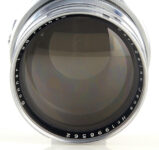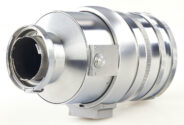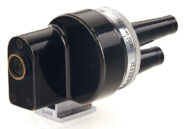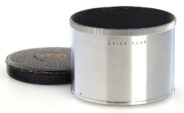Carl Zeiss Jena "Olympia" Sonnar 180mm F/2.8
Medium telephoto prime lens • Film era • Discontinued
Model history (3)
| ■Carl Zeiss Jena "Olympia" Sonnar 180mm F/2.8 | M | 5 - 3 | 2.00m | E77 | 1936 ● | |
| ■Carl Zeiss Jena "Olympia" Sonnar 180mm F/2.8 [T] [Flektoscope] | P | 5 - 3 | 2.00m | E77 | 1938 ● | |
| ■Carl Zeiss Jena "Olympia" Sonnar 180mm F/2.8 [T] [Flektometer] | P | 5 - 3 | 1.50m | E77 | 1951 ● | |
Features highlight

Specification
| Production details: | |
| Announced: | 1936 |
| Production status: | ● Discontinued |
| Original name: | Carl Zeiss Jena Sonnar 1:2,8 f=18cm |
| System: | Contax (1932) |
| Optical design: | |
| Focal length: | 180mm |
| Speed: | F/2.8 |
| Maximum format: | 35mm full frame |
| Mount and Flange focal distance: | Contax [34.85mm] |
| Diagonal angle of view: | 13.7° |
| Lens construction: | 5 elements in 3 groups |
| Diaphragm mechanism: | |
| Diaphragm type: | Manual |
| Aperture control: | Aperture ring |
| Number of blades: | <No data> |
| Focusing: | |
| Coupled to the rangefinder: | Yes |
| Closest focusing distance: | 2m |
| Focusing modes: | Manual focus only |
| Manual focus control: | Focusing ring |
| Physical characteristics: | |
| Weight: | 1525g |
| Maximum diameter x Length: | <No data> |
| Accessories: | |
| Filters: | Screw-type 77mm |
| Lens hood: | 1283/18 |
| Source of data: | |
| Scarce manufacturer's technical data + own research. | |
Manufacturer description #1
From the U.S. Zeiss magazine (April 1936):
The Zeiss Ikon Contax and Zeiss lenses played an important part in recording the thrills of the 1936 Winter Olympic Games. Illustrated is the Contax Gun made for use with the Contax and a specially constructed Zeiss f:2.8, 180mm. (7") Tessar. With the gun, the sports photographers were able to record the dramatic incidents of the games with ease and precision under almost any conditions. There will be more about the Contax Gun and its f:2.8 Tessar in an early issue.
LENS-DB: This is believed to be the first official U.S. announcement of the "Olympia" Sonnar 180/2.8.
Manufacturer description #2
This is the last word in lens construction and represents an entirely modern telephoto lens of extremely large aperture. It is the press and sports photographer's lens, which will produce a correctly exposed negative of fast moving objects, no matter what the lighting conditions may he.
Manufacturer description #3
A telephoto lens of extremely large aperture. It is the press and sports photographer's lens, which will produce a correctly exposed negative of fast moving objects, no matter what the lighting conditions may be.
From the ZEISS HISTORICA (Spring 1989, Vol. 11, No. 1)
The Olympia Sonnar, since its inception in 1936, has been the flagship of the Zeiss fleet of lenses. The 180 f:2.8 has always been special, and knowledgeable photographers have always associated it with Zeiss. It is a credit to Zeiss's ability to "read" a market not only that this lens has existed, in one form or another, in all of their own professional camera systems over the past 55 years, but that virtually all other 35mm. systems include a similar lens.
Over the half-century of the Olympia Sonnar's existence, it has been offered in many configurations, in a variety of optical formulae, in keeping with Zeiss's goal of incorporating the latest advances in design and materials into their products.
As the familiar story goes, Zeiss was pressured into designing a dramatic new high-speed, long-focus lens in time for the 1936 Winter Olympic Games. It was felt that such a lens would demonstrate the prowess of the German optical industry, while allowing selected German photographers to capture images of the games like none seen before, since miniature film technology had by then advanced to a point where such a lens could be exploited fully. Zeiss Ikon, the preeminent German manufacturer of optical equipment, was the logical choice for several reasons. First, the firm was the largest in its field in Germany, by a comfortable margin. Second, the Contax I, alone among its competitors, offered a reasonably reliable and accurate 1/1000 second top speed, which was useful for action shots. And Zeiss had a great deal of experience with high-speed lenses, notably through its incorporation of Ernernann in the 1926 merger. Zeiss, always eager to one-up the competition, accepted the challenge.
No one at the 1936 Winter Olympic Games could miss the imposing chrome lens - 22cm long and 9cm in diameter - with the huge chrome sunshade in place seen in the hands of a few German photographers. Both as a showpiece and as a tool, the Olympia Sonnar, as it quickly came to be known, must have exceeded expectations, for the new lens was an aesthetic masterpiece as well as a technical breakthrough.
The f:2.8 speed, considered fast in 1936 for a normal lens, was unprecedented for a long-focus lens. The well-known Sonnar formula was modified to a 5 element/3 group configuration, and a front element of 75mm diameter was incorporated to obtain the f:2.8 speed. With only six air-to-glass surfaces, reasonable flare control was achieved, especially with the sunshade in place. The iris setting ring was located at the front of the lens, and closed down to f:22. A quarter-turn of a broad knurled ring focussed the lens down to 3 meters.
The lens by itself weighed a hefty 1525 g. Located near the center of gravity of the lens was a sturdy, satin chrome tripod bushing which could be rotated to allow vertical format shots. One suspects that the decision on where to place the release (a tab located on the bottom of the lens just behind the tripod mount) was made by engineers rather than photographers, since it was very difficult to get to. Mounted on top of the same ring was an accessory shoe.
The specifications of the lens were especially remarkable when compared with the contemporary competition in the fledgling 35mm. market. E. Leitz offered a 200mm. f:4.5 Telyt in an erect-but-laterally-reversed-image reflex housing as their telephoto lens for the Leica system. In house, Zeiss had only the rangefinder-coupled 180mm. f:6.3 Tele-Tessar for the Contax. Both of these lenses were good performers, but not as sports optics, due to limited selective focussing ability and a lack of action-stopping ability with the films then available.
Having produced a superlative lens for action photography, the next challenge Zeiss faced was to help the user aim and focus it. If you were in no hurry, and precision was paramount, the groundglass adapter (5520/6), or the plate back (540/13) could be used to focus the tripod-mounted lens. Or you could mount one of the existing optical viewfinders (436/7 Universal, 436/1 Multiple or 436/11 Telefinder) already developed for use with the Tele-Tessar in the camera's accessory shoe with acceptable results, as long as you remembered that focussing and viewing had to be two separate operations. But none of these solutions was the real answer for the sports photographer, who would have to wait several years for a reflex housing.
From the Classic Camera magazine (May 1999)
Among the lenses Zeiss made for 35mm systems, few have the allure of the Sonnar 180mm f/2.8, better known as the Olympia Sonnar. This allure has not grown smaller with time and has actually survived the war years, the dismemberment of Zeiss, the end of the Contax rangefinder system and numerous changes to suit the systems of different makes.
A prestigious lens
Ever since it was officially launched in 1936 for the Garmisch winter Olympics, this lens was a qualifying element in the Contax range, for which it was specifically designed, becoming the symbol of Zeiss' high technology. As the number of lenses available for professional photographers following the winter Olympics was limited, the official launch of the Sonnar 180mm was postponed a few months to coincide with the Berlin Olympic games, hence the name Olympia Sonnar. The simultaneous launch of the Contax II and of the new ultra fast telephoto contrived to make for a world famous publicity stunt.
Before 1936, the longest lens coupled to the rangefinder was the four element Tele Tessar K 180mm f/6.3, which in itself represented a record for Contax, since the longest lens that could be coupled to the Leica rangefinder was the 135mm. However, it was clear that the slow speed of the Tele Tessar made it unsuitable to sports photography.
In this sector, Zeiss already offered two Sonnar lenses, the 50mm f/1.5 and the 80mm f/2.0, but both these focal lengths were unsuited for long distance shots, while the Sonnar 135mm had a maximum aperture of f/4.0. To design and make a longer lens with a maximum aperture of f/2.8 was considered a heroic feat.
The Leica system had been offering a 200mm f/4.5 for some time, but this was uncoupled from the rangefinder and could only be used with the PLOOT reflex box accessory. Astro, an independent Berlin based optical company offered for the Leica and Contax a series of fast telephotos called the Astro Portrait, with focal lengths of 150mm and 200mm and a maximum aperture of f/2.3, to be used with the Identoskop reflex box, but these lenses did not have the prestigious Zeiss brand. To make the 180mm telephoto, the Sonnar formula of six or seven elements in three groups was modified, only using five lenses, the front one with a 75mm diameter, still arranged in three groups. With only six air-glass interfaces, flare - even at full aperture - was considered acceptable. It has to be remembered that at the time the Sonnar 180mm was announced, lens coating was still undergoing experimentation, only being used in military spec lenses in the 1940s.
Compared to the 135mm, the Sonnar 180mm offered one third greater magnification and was one stop faster. Compared to the Tele Tessar of similar focal length, it was two and a half stops faster. In sports and reportage photography, this could mean the difference between a good photo and a useless one. Working with period film stock - which was never very fast - the possibility of using the full f/2.8 aperture meant shutter speeds of 1/125s or 1/250s, where others had to use 1/25s with greater possibilities of a blurred picture. The actual name "Sonnar" is derived from "Sonne", which is German for sun, and was used by Zeiss to indicate, even before the actual aperture was declared, that this was a fast lens.
Sonnar 180 for rangefinder systems
The Sonnar 180 f/2.8 was originally offered with a direct mount to the camera, completed with coupling to the rangefinder. As for all Contax lenses with a different focal length from 50mm, focusing and composing the frame required two separate actions. The 180mm either required the specific 436/11 optical viewfinder, or one of two universal finders, the 436/7 revolver and the 436/1. However, in spite of the wide rangefinder base, there were difficulties in focusing this lens due to the limited depth of field.
Other medium telephoto prime lenses in the Contax system
Sorted by focal length and speed, in ascending order
| ■Contax mount (3) | |||||||||
| Carl Zeiss Jena Sonnar 135mm F/4 [T] | M | 4 - 3 | 1.50m | E40.5 | 1932 ● | ||||
| Carl Zeiss / Zeiss-Opton Sonnar 135mm F/4 | M | 4 - 3 | 1.50m | E40.5 | 1950 ● | ||||
| Carl Zeiss Jena Tele-Tessar [K] 180mm F/6.3 | M | 4 - 3 | E40.5 | 1933 ● | |||||





